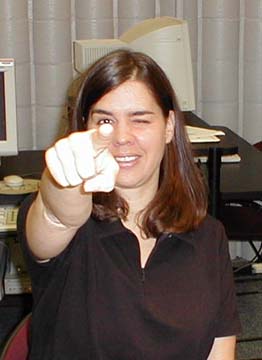Normally but not always, for someone who is right handed, everything should follow the masterhand. Eg, i can kick a football better with my left foot, have more muscles control of those on the right side of the body... etc.
So, how to determine your master eye?
Here's How:
- Choose two vertical edges or objects, one a few feet behind the other - looking through a doorframe to something on the wall behind is ideal.
- Stand about 10 feet away from the closest edge.
- Look carefully at the alignment of the edges or objects.
- Without moving, cover or close one eye and look at the objects with the other eye.
- Switch eyes, looking through the eye you had previously covered, and closing the other one.
- Look at the objects with both eyes again.
- You should now be able to identify which eye observed little or no real change, and which eye noticed a shift in the the objects. Repeat the previous steps if needed.
- The eye which observed a change in the objects is your non-dominant eye. The eye which observed the same view as with both eyes open is your dominant eye!
 1. Stretch one arm in front of you and point at a distant object.
1. Stretch one arm in front of you and point at a distant object. (Note, People who do not have a dominant eye often have a hard time pointing because they see two fingers. )
2. Close your right eye, Don't move your finger.
3. Did your finger appear to move as you closed your eye?
4. Open both eyes and point again.
5. This time close your left eye.
6. If when you close an eye, the finger appears to jump in relation to the background, then the eye you closed is your dominant eye.
- Close your left eye and see a finger jump, you are left eye dominant.
- Close your right eye and see a finger jump, you are right eye dominant.
- See two fingers when you try to point, neither eye is strongly dominant.
7. Repeat the above activities using the other arm to point, see if you get the same answer for your dominant eye.
If you do, this is strong indication that you have a dominant eye.
Tips:- The dominant eye is often, but not always, on the same side as the master hand.
- You will usually unconsciously choose your dominant eye when peering through a telescope or camera viewfinder.
- Eye dominance has been shown to have no effect on sporting performance, and articles to the contrary are based on 'urban myth'.











No comments:
Post a Comment